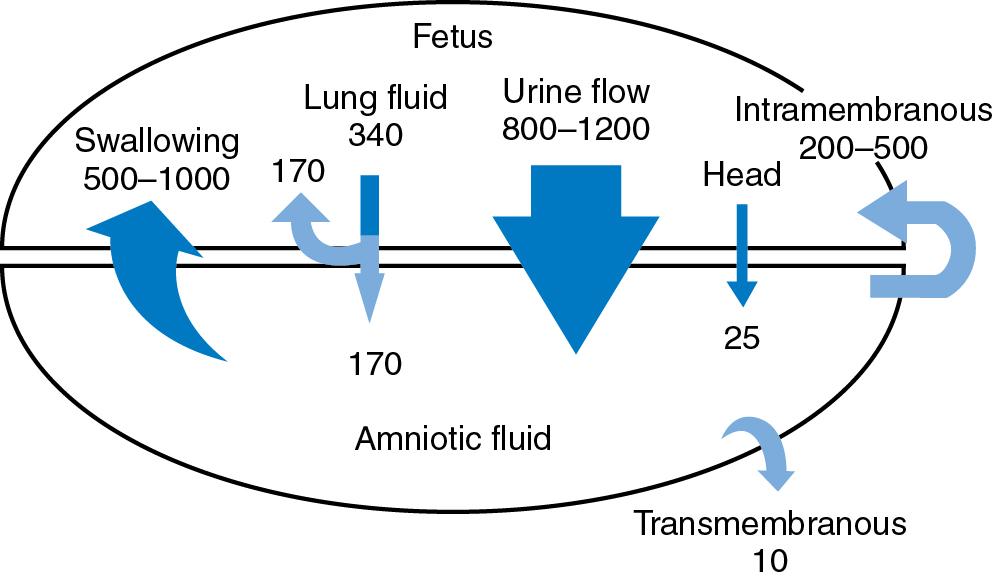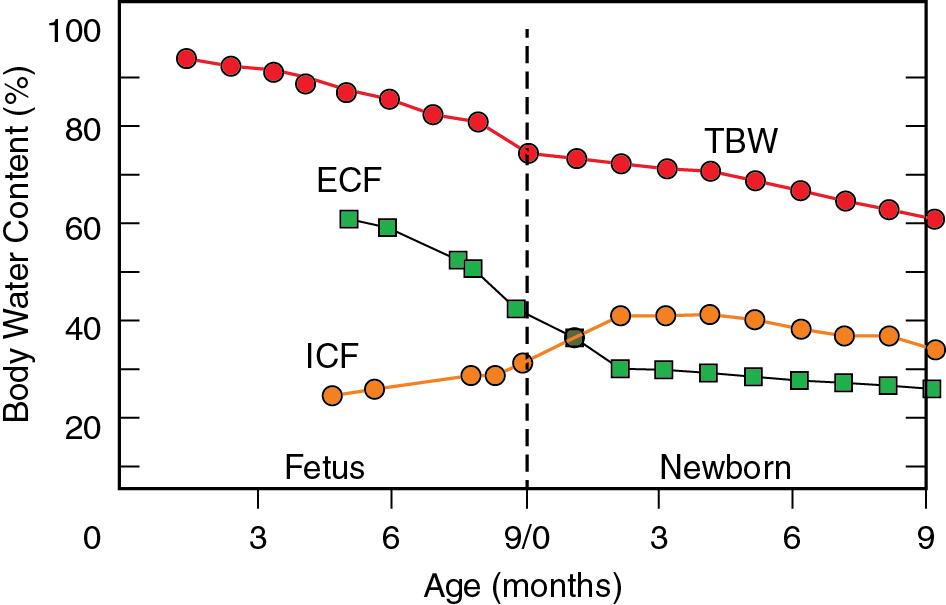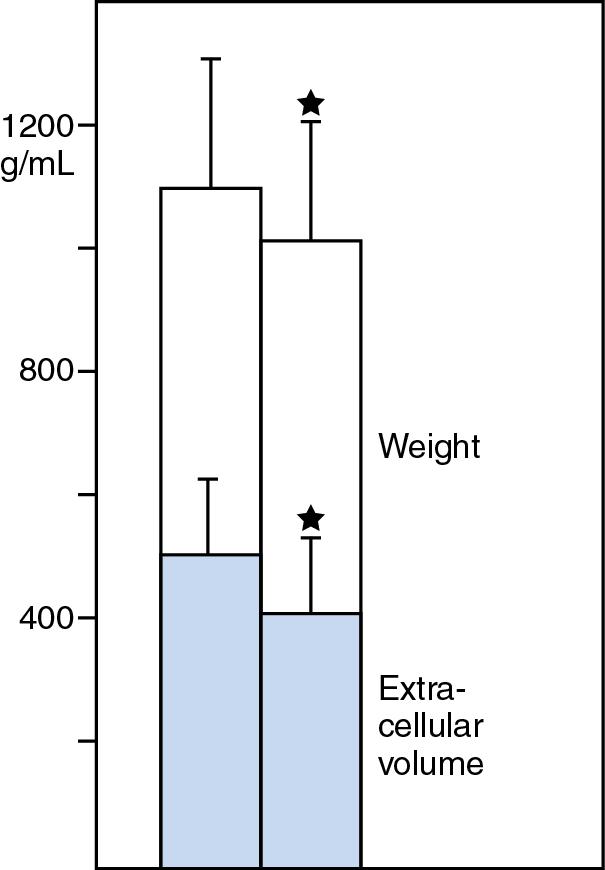Physical Address
304 North Cardinal St.
Dorchester Center, MA 02124
Fluid and electrolyte management is an important and challenging part of the initial care of any very premature or critically ill newborn. The transition from fetal to neonatal life is associated with major changes in fluid and electrolyte homeostasis and total body balance. Before birth, the fetus has a constant and ready supply of water and electrolytes; homeostasis is largely a function of maternal and placental mechanisms. After birth, newborns must rapidly assume responsibility for their own fluid and electrolyte homeostasis in an environment in which water and electrolyte availability and losses are much more variable and less subject to feedback control than in utero . Moreover, significant contraction of the extracellular fluid (ECF) space occurs with the transition from fetal to neonatal life. In very premature newborns, this transition is also associated with a change in internal potassium (K) balance: K shifts from the intracellular fluid (ICF) space to the ECF space. The goal of fluid and electrolyte therapy in the immediate postnatal period is not to maintain fluid and electrolyte balance but to allow the appropriate changes in balance to occur without detrimental perturbations in fluid and electrolyte status.
The fetus receives all of its 1995 water for growth transplacentally. Placental water balance is regulated by aquaporins, which are found throughout the female genital tract. Net water fluxes are relatively small ( ), but larger volumes of water are exchanged between the fetus, amniotic fluid, and maternal circulation ( Fig. 3.1 ).

Early in gestation, the fetus is about 95% water, with the vast majority in the extracellular fluid space. As gestation progresses, the percentage of total body water decreases because of the accumulation of body solids (protein, fat, and minerals) ( Fig. 3.2 ). As a proportion of body weight, the extracellular fluid space decreases and intracellular water increases because fetal growth later in gestation occurs by cell enlargement rather than by cell division. The average term fetus contains 3000 mL of water, of which 1000 mL is intracellular and 350 mL is intravascular. Urine output is brisk during fetal life and may reach 1000 mL/day at term gestation.

In fetuses with abnormal growth, there are perturbations in body composition. For example, large for gestational age (LGA) infants have higher total body fat and mineral content but less lean body mass ( ). In growth-restricted infants, total body water is increased (compared with appropriately grown infants). That reflects decreased protein and mineral accumulation in the growth-restricted population ( ). Furthermore, adipose tissue is markedly reduced at term gestation.
A weight loss of about 5% to 12% is almost invariable during the first week of life in preterm infants ( ; ; ). Although inadequate caloric intake may contribute to this weight loss, multiple studies have found that it results in large part from contraction of the ECF space after birth ( ; ; ; ; ; ) ( Fig. 3.3 ). The following data suggest that contraction of the ECF space is physiologic:
It occurs in spite of large variation in water and sodium (Na) intake ( ; ).
It occurs even if caloric/protein intake mitigates postnatal weight loss ( ).
When postnatal weight loss is regained, ECW volume per kg body weight remains stable at the new lower level ( ).
Attenuation of this decrease may be associated with increased morbidity ( ; ; ).

Negative total body water (TBW) and total body sodium (TBNa) balances are associated with contraction of ECF space. In most infants, the excretion of water and Na that occurs as a result of contraction of the ECF space in the first few days of life is not gradual. In fact, a characteristic pattern of fluid and electrolyte adaptation, which is largely independent of fluid and electrolyte intake, is observed in the first week of life in the majority of very low birth weight (VLBW) newborns ( ; ; ; ). Usually three phases can be distinguished. Table 3.1 summarizes the changes in fluid and electrolyte balance, ECF volume, and renal function associated with each phase. Tables 3.2 , 3.3 , and 3.4 summarize recommended water, Na, and K intakes during the first month of life.
| Phase | Prediuretic | Diuretic/Natriuretic | Homeostatic |
|---|---|---|---|
| Age | ∼ Birth–2 days | ∼ 1–5 days | After ∼ 2–5 days |
| Urine output | Low | Abrupt ↑↑ | ↓ then α intake |
| Sodium excretion | Minimal | Abrupt ↑↑ | ↓ then α intake |
| Potassium excretion | Minimal | Abrupt ↑↑ | ↓ then α intake |
| Water balance | < intake − IWL | Markedly negative | ∼ α sodium balance |
| Sodium balance | ∼ negative | Markedly negative | Stable, then positive with growth |
| Potassium balance | ∼ negative | Markedly negative | Stable, then positive with growth |
| ECF volume (mL) | Stable or ∼ ↓ | Abrupt ↓↓ |
|
| Creatinine clearance | Low | Abrupt ↑↑ | ± ↓ then gradual ↑ with maturation |
| Weight Grams | Weight loss % of bw | Water mL/kg/day | Na mEq/kg/day | Cl mEq/kg/day | K mEq/kg/day |
|---|---|---|---|---|---|
| <1000 | 10% | 90–140 | 0–1 | 0–1 | 0 |
| 1001–1500 | 8%–10% | 80–120 | 0–1 | 0–1 | 0–1 |
| 1501–2000 | 6%–8% | 70–100 | 0–1 | 0–1 | 0–1 |
| >2000 | 6%–8% | 60–80 | 0–1 | 0–1 | 0–1 |
| Weight Grams | Weight loss % of bw | Water mL/kg/day | Na mEq/kg/day | Cl mEq/kg/day | K mEq/kg/day |
|---|---|---|---|---|---|
| <1000 | 0% | 80–120 | 2–3 | 2–3 | 1–2 |
| 1001–1500 | 0% | 80–120 | 2–3 | 2–3 | 1–2 |
| 1501–2000 | 0% | 80–120 | 2–3 | 2–3 | 1–2 |
| >2000 | 0% | 80–120 | 2–3 | 2–3 | 1–2 |
| Weight Grams | Weight Gain g/kg/day | Feedings mL/kg/day | Na mEq/kg/day | Cl mEq/kg/day | K mEq/kg/day |
|---|---|---|---|---|---|
| <1000 | 15–20 | 150–200 | 3–5 | 3–5 | 2–3 |
| 1001–1500 | 15–20 | 150–200 | 3–5 | 3–5 | 2–3 |
During the first 12 to 48 hours of life, the urine flow rate is low (0.5–3 mL/kg/hour), regardless of intake. Therefore during this prediuretic phase, excretion of Na and K is also quite low; insensible water loss (IWL) is the major route of water loss. At the same time, the low glomerular filtration rate (GFR) in the immediate perinatal period limits the infant’s ability to excrete water and electrolyte loads.
As the diuretic/natriuretic phase begins, an abrupt increase in urinary water and Na occurs independent of water and Na intake and heralds contraction of the ECF space. Early in the diuretic/natriuretic phase, serum Na concentration ([Na + ]) often rises because water balance is more negative than sodium balance. The majority of body weight loss occurs during this phase. A fall in serum K concentration ([K + ]) can be anticipated as increased delivery of water and Na to the distal nephron stimulates K secretion and kaliuresis. As the ECF space stabilizes at an appropriate volume, urinary water and electrolyte excretion decrease and begin to vary appropriately with intake.
This negative TBW and TBNa balance and reduction of ECF volume during the postnatal diuresis/natriuresis in the immediate newborn period may represent excretion of fetal pulmonary fluid, which is absorbed from the alveolar space and interstitium of the lung before delivery and in the immediate postnatal period.
The serum [K + ] rises in the first 24 to 72 hours after birth in very premature infants, even in the absence of exogenous K intake or renal failure ( ; ). This increase results from the shift of K from the ICF space to the ECF space; urine outputs are usually normal in affected infants (i.e., nonoliguric hyperkalemia). The magnitude of this shift correlates roughly with the degree of prematurity. Clinically significant hyperkalemia rarely occurs after 30 to 32 weeks of gestation ( ). In contrast, nonoliguric hyperkalemia used to be fairly common in infants weighing less than 1000 grams at birth or born before 28 weeks’ gestation ( ; ; ; ; ). However, the use of antenatal steroids and enhanced postnatal nutrition have decreased the risk of nonoliguric hyperkalemia ( ) in extremely low birth weight (ELBW) infants.
With the clamping of the umbilical cord at birth, the supply of glucose and other nutrients from the mother ceases and neonatal glucose production begins. As a result, serum glucose concentration ([GLU]) falls sharply over the first 45 to 90 minutes of life ( ; ; ). In response to this fall in serum glucose concentration, there are abrupt increases in the levels of epinephrine, norepinephrine, and glucagon with a concomitant fall in insulin. Although the effect of these counterregulatory hormones on glucose metabolism is not as robust as in the adult, these responses mobilize glucose from glycogen stores and promote gluconeogenesis. Glucose utilization averages 4 to 8 mg/kg/minute in term and preterm newborns ( ; ). Endogenous glucose production may be inadequate to maintain a normal serum [GLU] in infants with prematurity, perinatal stress, or intrauterine growth restriction. In this case exogenous administration of glucose at a rate that matches the rate of glucose utilization is necessary to conserve glycogen stores and prevent hypoglycemia ( ).
Premature infants are also at increased risk for hyperglycemia with exogenous glucose infusions because of a decreased hepatic responsiveness to insulin and a greater metabolic clearance rate for insulin ( ).
Ms. G is admitted at 25 weeks’ gestation with advanced cervical dilation. She is given two doses of betamethasone and monitored on the antepartum unit. At 26 weeks’ gestation she goes into labor and delivers a 750 gram male infant. He is placed on a radiant warmer, covered with a thin plastic wrap, intubated, and transferred to an isolette with 85% relative humidity. The infant has umbilical venous and arterial catheters placed and receives dextrose containing IV fluids at a rate of 120 mL/kg/day. Serum electrolytes show [Na + ] 137 mEq/L at 8 hours of life, 133 mEq/L at 16 hours of life, and 131 mEq/L at 24 hours of life. The following morning the infant has made 0.9 mL/kg/hour of urine and at that time, the infant weighs 755 grams.
Why has this infant developed hyponatremia?
What corrective measures should be taken?
How much sodium should be administered in the first few days of life?
Serum sodium concentrations are dependent on total body water and total body sodium content. Before the very low birth weight (VLBW) infant begins to diurese (the prediuretic phase), sodium losses are low because the urinary output is diminished (see later) and urine sodium concentrations are low. The range of urine Na losses is 1 to 3 mmol/kg/day ( ). As a result, the serum sodium concentration is primarily affected by changes in total body water. During the prediuretic phase (first 24–36 hours of life) urine production and urine flow rates are diminished with a range of 0.5–3 mL/kg/hour ( ). Stool water losses are also low, and insensible water losses account for the majority of water loss. When initiating IV fluids, the clinician must estimate insensible water losses and adjust water administration based on each patient’s individual needs. This infant has relatively low urine output with falling serum sodium and a mild increase in body weight (~1%). Most infants will lose weight by day 2 of life, but in this case the infant has gained weight. This infant’s water intake has exceeded water losses and he has developed hyponatremia. In addition, with any increase in intravascular volume, sodium excretion will increase secondary to the release of atrial natriuretic peptide.
The infant’s water intake should be decreased to account for less insensible water losses than anticipated. In this case a 20 mL/kg/day decrease in total fluids would be appropriate.
No sodium should be administered, because the newborn infant needs to contract the extracellular fluid space (containing excess sodium) to undergo the physiologic transition to postnatal life.
The rate of fluid administration is decreased from 120 mL/kg/day to 100 mL/kg/day. The following day the infant’s urine flow rate increased to 3.5 mL/kg/hour; the infant now weighs 720 grams. The serum [Na + ] is 138 mEq/L. After discussing the physiologic contraction of the extracellular fluid space in VLBW infants on morning rounds, the pediatric resident asks if there are risks associated with providing excess fluid and interfering with that process. Several randomized controlled trials have examined the risks associated with liberal versus restricted fluid administration in preterm infants early in life. A metaanalysis of these studies showed a significant increase in the incidence of necrotizing enterocolitis and patent ductus arteriosus in infants who received higher IV fluid rates that resulted in little to no weight loss. The groups who received lower fluid intake had greater weight loss without a significant increase in dehydration ( ).
Become a Clinical Tree membership for Full access and enjoy Unlimited articles
If you are a member. Log in here